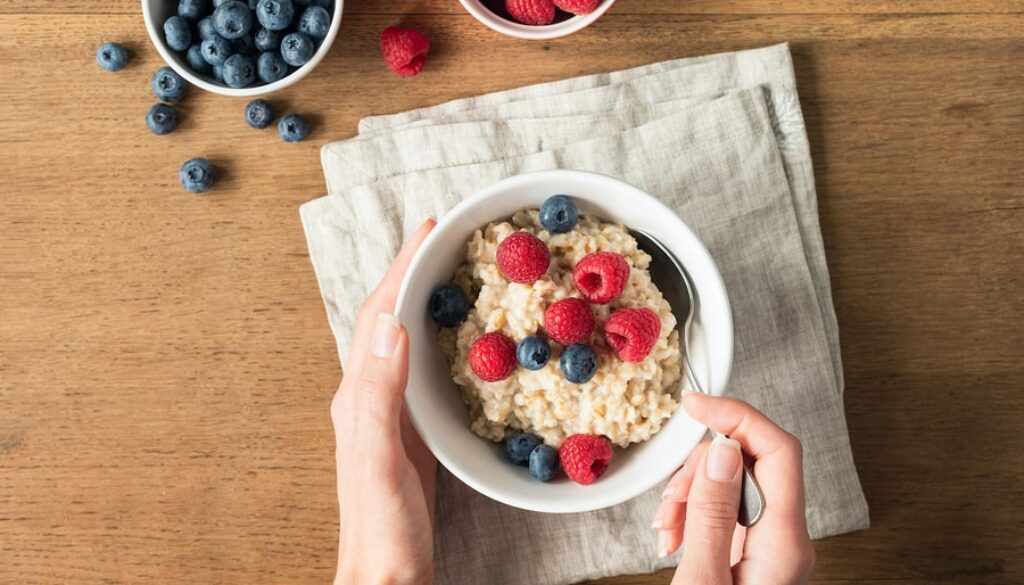5 Foods You Should Eat Every Day
Happy National Nutrition Month! It’s a great time of the year to take some time to check in on what our daily nutrition looks like and see if our current habits are meeting our needs. With the holidays and the Girl Scout cookies behind us, many of us are looking forward to getting outside and becoming more active as the weather (finally) begins to warm up. Good nutrition helps provide us with the energy to participate and to feel good while our calendars fill up.
I often get asked, “What are the easiest ways to improve my diet?” and it’s a hard question to answer. Optimum nutrition is highly individualized and dependent on variable lifestyle factors. However, if I only had 5 minutes to help a patient improve their diet, I’d say that the changes that have the biggest impact would be to eat more plant-based foods and drink more water. Easier said than done, right? Busy lifestyles tend to make adequate nutrition challenging, so incorporating some very nutrient-dense foods every day can make meeting our needs easier. I recommend eating the 5 following foods daily to really add a nutritional punch to your routine, and to get some of the most lacking nutrients in a typical American diet.
Eat These 5 Foods Daily To Add A Nutritional Punch To Your Routine
1. BLUEBERRIES
Blueberries are full of antioxidants! This also makes them anti-inflammatory. Antioxidants are compounds that work to neutralize free radicals so they can’t facilitate cell damage and mutation. This helps to decrease the risk of cancer. The antioxidants in berries are called anthocyanins and provide that rich, dark color. Anthocyanins have been shown to help improve mood by activating certain neural pathways in the brain and reducing effects of stress hormones. For their size, blueberries are low in sugar and high in fiber. They have 3.6 grams of fiber per 1 cup, which is about 12% of the average person’s need. One cup contains 85 calories and 15 grams of carbohydrate (which also makes them a diabetic-friendly snack). They also contain vitamin C, vitamin K, manganese, vitamins B6 and E, thiamine, riboflavin, folate, choline, and copper. Enjoy 1 cup per day.
How to incorporate more blueberries:
- Pair with nuts for a healthy snack
- Add to plain Greek yogurt for a quick, low-sugar breakfast
- Add a handful to a salad, smoothie, or oatmeal
- Use in place of jelly on a PB&J
- Mash with a little bit of water, heat to reduce, and use as a sauce drizzled over chicken
2. WALNUTS
Walnuts are one of the best plant-based sources of omega 3 fatty acids. This particular fat is considered “essential” because our bodies cannot produce it and we need to get it from our diet. Omega 3 fats are in the form of ALA in walnuts, which can be converted to EPA and DHA in the body (the same type we get from salmon, and the most usable). Recommendations for ALA are 1.1 grams for adult females and 1.6 grams for adult males. One ounce of walnuts provides 2.5 grams of ALA.
Omega 3 fats help to reduce inflammation in the body; lower inflammation decreases the risk of developing chronic diseases. They also help to keep cholesterol levels in check.
Walnuts are also a good source of unsaturated fat, manganese, copper, magnesium, folate, and vitamin B6. Remember that because walnuts contain a large percentage of (healthy) fat and therefore calories, portion size matters. Enjoy 1 ounce per day, or 14 halves.
How to incorporate more walnuts:
- Add a handful to salad
- Pair with a handful of apricots and dried (unsweetened) coconut for a power snack
- Use in place of pine nuts in homemade pesto
- Crush and use as a crust on dinner protein
- Dip in dark chocolate for dessert
3. SPINACH
Spinach is loaded with vitamins and minerals. It provides magnesium, potassium, iron, and calcium. It’s high in vitamins K and A, and folate. Spinach also contains fiber, water, and antioxidants like lutein and zeaxanthin. These help to support eye health. We get all these benefits for only 7 calories per cup! These nutrients are usable whether spinach is raw or cooked, making this one of the most versatile foods to use to amp up daily nutrition.
It’s best to pair spinach with foods that contain vitamin C to help with iron absorption from this plant source. Eat with tomatoes, bell peppers, orange slices, or strawberries.
Enjoy as much as you like!
How to incorporate more spinach:
- Mix with other greens for a salad base
- Add chopped spinach to an omelet or crustless quiche
- Throw a handful into a smoothie
- Add to a sandwich or wrap instead of lettuce
- Mix a cup into soups, tomato sauce, or grains
- Use as a dinner side lightly sautéed in olive oil, with garlic and parmesan
4. AVOCADO
Avocados are filling, creamy, anti-inflammatory, and full of wonderful nutrition. They’re good for the heart, the gut, the brain, the hair and skin, and for improving cholesterol and blood pressure. An avocado is high in monounsaturated fat, which supports healthy cholesterol levels, lowering LDL (the “bad”) cholesterol, slowing down a rise in blood sugar, and keeping hair and skin healthy. One medium avocado contains 9 grams of fiber! That’s 30% of what an average adult needs daily. Fiber works to keep our gut functioning appropriately and to keep us feeling full for a long time.
Technically a fruit, avocados are high in potassium, which helps to regulate blood pressure, and magnesium, which helps to support nerve and muscle function, along with lowering stress hormones and helping with sleep. Avocados also provide us with vitamins A, K, C, E, B6, folate, pantothenic acid, and choline. Enjoy ½-1 medium avocado per day.
How to incorporate more avocado:
- Slice and add on top of salad, chili, tacos, and sandwiches
- Mash, add herbs and spices, and use as a spread in a wrap, taco, or sandwich
- Fill with chicken salad, an egg, or quinoa with a balsamic glaze (delicious!). You can also swap the mayo in that chicken salad for mashed avocado.
- Use to make creamy salad dressings and sauces
- Use in desserts like brownies, pudding, or chocolate mousse
- Toss into a smoothie to make it creamy
5. BEANS
Beans, also known as legumes or pulses, are a budget-friendly way to add a whole lot of nutrition to almost any meal. Beans have an average of 230 calories per one cup, with 15 grams of protein and 15 grams of fiber. This combination will keep you full until it’s meal time again and stabilize blood sugar for good energy levels. Beans are considered a prebiotic food, which means they feed the good bacteria in our digestive system to keep our gut microbiome healthy. They’re a good source of folate as well, which is necessary for forming red blood cells, using proteins, and replicating DNA.
Beans also provide thiamin (B1), magnesium, potassium, phosphorus, iron, manganese, copper, and zinc. They provide polyphenols too, which are antioxidants that decrease inflammation and help control the rate of aging. (Beans for fewer wrinkles? Sign me up!). Enjoy at least ½ cup per day.
How to incorporate more beans:
- Add to salads, soups, chilis, omelets, tacos, and wraps
- Make fresh hummus out of any bean; use as a dip or as a spread in place of mayo
- Use in meatless meals to provide protein
- Make a cold bean salad with veggies for a quick and portable lunch
- Add to brownies
Raleigh Medical Group has a registered dietician on staff to provide health consultations. Schedule an appointment with Nicole Matala.




